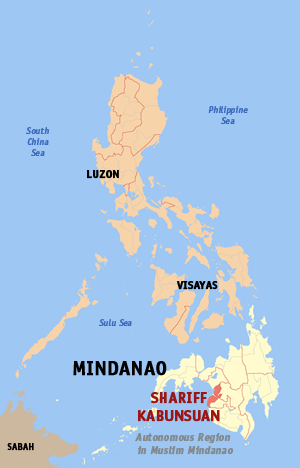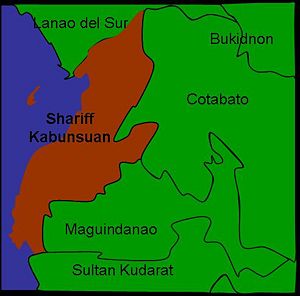Shariff Kabunsuan
| Province of Shariff Kabunsuan | |
Provincial seal of Shariff Kabunsuan |
|
 Map of the Philippines with Shariff Kabunsuan highlighted |
|
| Region | Autonomous Region in Muslim Mindanao (ARMM) |
| Capital | Datu Odin Sinsuat |
| Divisions | |
| - Highly urbanized cities | 0 |
| - Component cities | 0 |
| - Municipalities | 11 |
| - Barangays | 209 |
| - Congressional districts | 1 |
| Population | |
| - Total (2007) | 365,848 |
| - Density | Expression error: Unexpected * operator|0}} /sq mi) () |
| Area | |
| - Total | Expression error: Unexpected * operator|0}} sq mi) |
| Founded | October 28, 2006 |
| Spoken languages | Iranon , Maguindanaon |
| Governor | Datu Bimbo Sinsuat |
Shariff Kabunsuan was a province of the Philippines in the Autonomous Region in Muslim Mindanao (ARMM). Muslim Mindanao Autonomy Act No. 201 provided for the creation of the new Province of Shariff Kabunsuan comprising the municipalities of Barira, Buldon, Datu Odin Sinsuat, Kabuntalan, Matanog, Parang, Sultan Kudarat, Sultan Mastura, and Upi, all of the first legislative district of the mother province of Maguindanao. Cotabato City, which is independently governed and does not vote for provincial officials, belongs to neither Maguindanao nor Shariff Kabunsuan. However, for the purposes of congressional representation the said city is grouped with Shariff Kabunsuan, as per Section 5 of MMA Act No. 201. The province ceased to exist by virtue a Supreme Court decision issued on July 17, 2008.
At the time of its creation, Shariff Kabunsuan was the country’s 80th province and the sixth in the Autonomous Region in Muslim Mindanao. It is the first province not made by Congress, as it was made through invoking the powers of Republic Act No. 9054 or the Expanded ARMM law.
On October 29, 2006, the creation of the new province of Shariff Kabunsuan was ratified by the affirmative majority (285,372) votes cast in a plebiscite. Only 8,802 voted for its rejection.
On December 30, 2006, the creation of the new municipality of Northern Kabuntalan was ratified by the affirmative majority votes cast in a plebiscite.
On July 17, 2008, the Supreme Court, in Sema v. Comelec declared the creation of the province of Shariff Kabunsuan void and ruled that the power of ARMM’s legislature to create provinces and cities is unconstitutional. [1]
Contents |
Political divisions
Shariff Kabunsuan was composed of 11 municipalities in two Sanggunian districts:
First District
| Municipality | No. of Barangays |
Population (2000) |
Area (km²) |
Pop. density (per km²) |
|
|---|---|---|---|---|---|
| Barira |
|
|
|
|
|
| Buldon |
|
|
|
|
|
| Matanog |
|
|
|
|
|
| Parang |
|
|
|
||
| Sultan Mastura |
|
|
|
|
|
| Sultan Kudarat (Nuling) |
|
|
|
||
Second District
| Municipality | No. of Barangays |
Population (2000) |
Area (km²) |
Pop. density (per km²) |
|
|---|---|---|---|---|---|
| Datu Blah T. Sinsuat |
|
|
|||
| Datu Odin Sinsuat (Dinaig) |
|
|
|
|
|
| Kabuntalan (Tumbao) |
|
|
|
||
| Northern Kabuntalan |
|
|
|||
| Upi |
|
|
|
||
History
The province was named after Shariff Mohammed Kabungsuwan, an Arab-Malay Islamic preacher who introduced Islam to central Mindanao in the 16th century.
Null and void creation
On July 16, 2008 the Supreme Court of the Philippines's 33-page judgment (8-6) penned by Antonio Carpio annulled "Muslim Mindanao Autonomy Act 201", which created Shariff Kabunsuan (carved out of Maguindanao, Autonomous Region in Muslim Mindanao). Justice Antonio Carpio's opined: “Only Congress can create provinces and cities because the creation of provinces and cities necessarily includes the creation of legislative districts. Creation of province or a city inherently involves the power to create a legislative district. The Constitution mandates that a province or a city with at least 250,000 inhabitants is entitled to at least one representative." The Court also declared unconstitutional the RLA’s power to create provinces and cities in the region but it did not pass upon the constitutionality of the creation of new municipalities and barangays. Under Republic Act No. 9140 or the Expanded ARMM Law, the RLA has the power to create new LGUs and to set its own criteria in creating, dividing, merging, or abolishing LGUs.[2]
References
- COMELEC Resolution No. 7727, Plebiscite to ratify the creation of the Province of Shariff Kabunsuan
- ABS-CBN News - Maguindanao votes to create new province
- ‘Mr shut up’ Dilangalen is back in the race
- Inquirer.net, Sultan Kudarat town aims for nat’l recognition

See also
- Sema v. Comelec
References
|
|||||